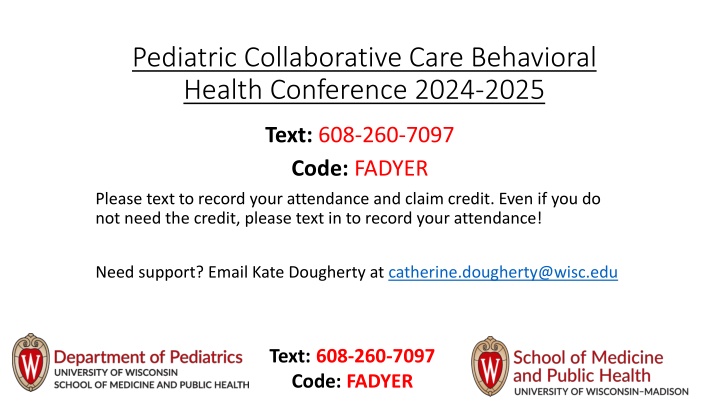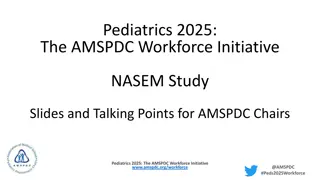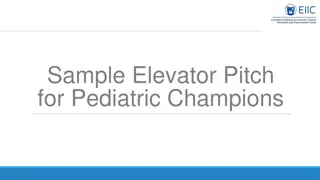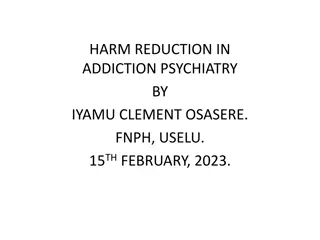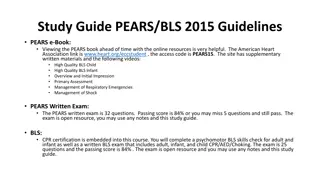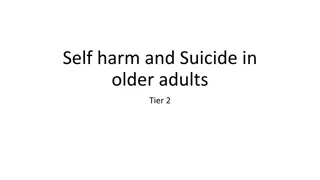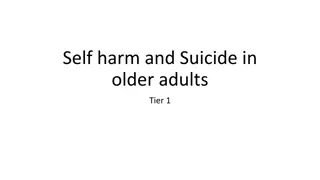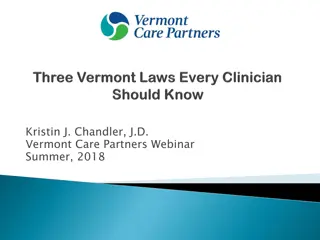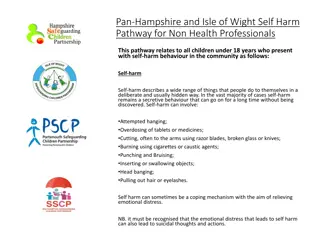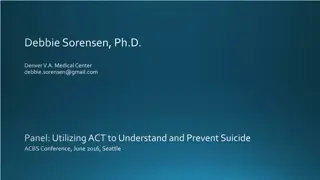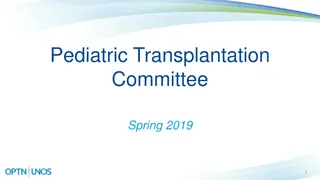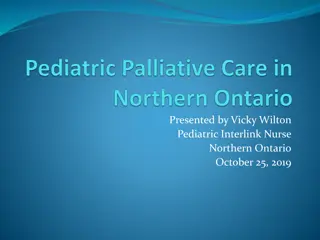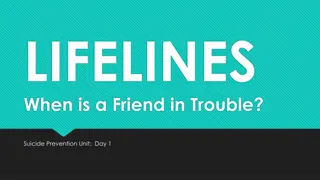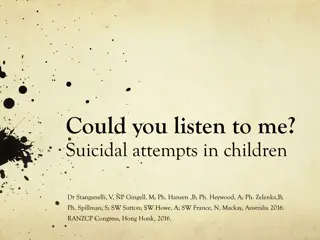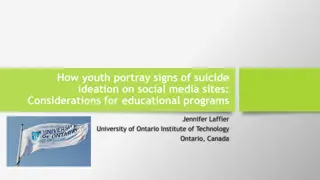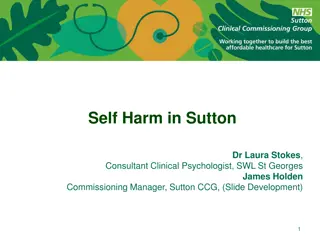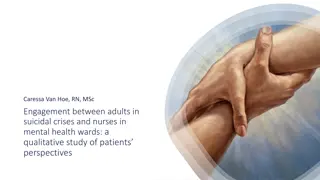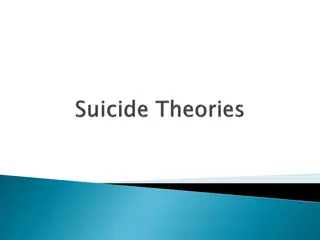Pediatric Self-Harm & Suicidal Ideation Assessment 2025
Rates of suicidal ideation and self-harm in teens, assessing risk factors, creating safety plans, coping strategies, and follow-up care in pediatric populations. Gain insights on effective documentation and support resources.
Download Presentation

Please find below an Image/Link to download the presentation.
The content on the website is provided AS IS for your information and personal use only. It may not be sold, licensed, or shared on other websites without obtaining consent from the author.If you encounter any issues during the download, it is possible that the publisher has removed the file from their server.
You are allowed to download the files provided on this website for personal or commercial use, subject to the condition that they are used lawfully. All files are the property of their respective owners.
The content on the website is provided AS IS for your information and personal use only. It may not be sold, licensed, or shared on other websites without obtaining consent from the author.
E N D
Presentation Transcript
Pediatric Collaborative Care Behavioral Health Conference 2024-2025 Text: 608-260-7097 Code: FADYER Please text to record your attendance and claim credit. Even if you do not need the credit, please text in to record your attendance! Need support? Email Kate Dougherty at catherine.dougherty@wisc.edu Text: 608-260-7097 Code: FADYER
Assessment and Management of Pediatric Self-Harm and Suicidal Ideation in Primary Care HANNAH KOERTEN, PHD MARCH 18, 2025 PEDIATRIC COLLABORATIVE CARE BEHAVIORAL HEALTH CONFERENCE SESSION #12
Conflict of Interest The planner and speaker of this CE activity has no relevant financial relationships with ineligible companies to disclose. The speaker does not intend to discuss any unlabeled or unapproved use of drugs or devices. Text: 608-260-7097 Code: FADYER
Please take a moment at the end of the session to complete your evaluation. Thank you! Text: 608-260-7097 Code: FADYER
Learning Objectives After completion of this session, participants will be able to: 1. Outline a thorough assessment of self-harm behaviors and suicidal ideation in pediatric populations. 2. Create a safety plan, including environmental safety (e.g., parental supervision or check-ins, removing dangerous items, school safety). 3. Explain effective coping strategies (e.g., TIPP, grounding exercises) as replacement behaviors for self-harm and/or suicide behaviors. 4. Assess level of follow-up care needed based on assessment of risk (e.g., ER evaluation, follow-up visits with therapists/psychiatrists or primary care) 5. Discuss efficient and thorough documentation of assessment, safety plan, and follow-up care.
Outline Rates of Suicidal Ideation (SI) and Self-Harm in Teens SI and Self-Harm Assessment Safety Planning Follow-Up Care Coping Strategies Throughout the presentation, I have included my personal dot phrases and some helpful resources (e.g., handouts, websites, videos).
Rates of Suicidal Ideation and Self-Harm Approximately 19% of adolescents seriously consider attempting suicide (Ivey-Stephenson et al., 2020) SI rates are higher for females (24%) than males (13%), and higher for lesbian, gay, or bisexual teens (47%) than for heterosexual teens (15%). Transgender and non-binary teens have the highest rates of SI (53%). Approximately 9% of adolescents report one or more suicide attempt Attempt rates are higher for females (11%) than males (7%), and for Black teens (12%) than Hispanic (9%) or White (8%) teens. As with SI, transgender and non-binary teens have the highest rates of SA (26%). Approximately 16% of adolescents engage in self harm (Farkas et al., 2024) Self-harm rates are higher for females (19%) than males (13%) Note: Data on transgender/non-binary youth come from a corrected report (Suarez et al., 2023)
UW Health Initial Assessment Teen forms (ages 12-17) at UW preventative care visits include the following question: Have you ever seriously thought about killing yourself, tried to kill yourself, or have purposely cut, burned, or otherwise hurt yourself? A yes to this question can mean many different things! Passive SI: Sometimes I wish I was dead. Active SI with no plan or intent: I want to kill myself, but I know I won t actually do it. Active SI with plan and intent: I am going to kill myself by taking my medications. Self-Harm (e.g., cutting on arms/thighs with sharp objects without intent to die) Teens may also deny self-harm on the form, but you see signs of self-harm during the physical exam
Case Example You are seeing Sam, a 16-year-old Hispanic non-binary teen, for a yearly well-check. They have a history of mild depression and anxiety. Sam has never met with a therapist or psychiatrist. Sam endorsed thoughts of self-harm or SI on the preventative form. We will walk through each of the following for Sam s visit: Assessment Safety Planning Follow-Up Care Coping Strategies
Assessment Suicidal Ideation *Passive Thoughts Have you wished you were dead or wished you could go to sleep and not wake up? *Active Thoughts Have you had thoughts of killing yourself? Frequency How often do you have these thoughts? Timing When is the most recent time you had these thoughts? When did you first start to have these thoughts? Adapted from the Columbia-Suicide Severity Rating Scale (2008)
Assessment Suicidal Ideation Plan Have you been thinking about how you might kill yourself? Access Do you have access to any dangerous items (e.g., guns, medications, anything specifically mentioned in plan)? Intent Have you had these thoughts and had some intention of acting on them? Or have you had thoughts but known that you will definitely not act on them? Actions Have you ever done anything, started to do anything, or prepared to do anything to end your life? When? Adapted from the Columbia-Suicide Severity Rating Scale (2008)
Assessment Documentation Suicidal Ideation Suicide Risk Assessment Passive Thoughts: Yes, I wish I were dead. Active Thoughts: Yes, I want to kill myself; no one wants me here anyway. Frequency: Every day Most Recent Thoughts: Today Duration: Started one month ago after a friendship ended Plan: Taking too many ibuprofen Access: Yes (bathroom cabinet) Intent: I want to die but I know I won t actually do it Actions: None Dot Phrase: .SUICIDEASSESSHRK
Assessment Self-Harm *Self-Harm Have you ever hurt yourself on purpose, without intending to kill yourself? Method What do you do to hurt yourself (e.g., cutting, scratching, burning, biting)? Frequency How often have you hurt yourself on purpose? Timing When is the most recent time you hurt yourself on purpose? When did you first start? Adapted from the Self-Harm Behavior Questionnaire (2001)
Assessment Self-Harm Location Where on your body do you hurt yourself? Severity How severe are the injuries? Have you ever needed medical attention (even if you didn t get it)? Access Do you use any items (e.g., knife, scissors) to hurt yourself? After-Care How do you care for your injuries? (e.g., cleaning, bandages) Adapted from the Self-Harm Behavior Questionnaire (2001)
Assessment Documentation Self Harm Self-Harm Assessment Self-Harm: Yes Method: Cutting Frequency:Twice Most Recent Self-Harm: Yesterday Duration: First started two weeks ago Location: Forearms Severity: Some bleeding, no stitches needed Access: X-Acto blade (for art) After-Care: Wash with soap and water, band-aids Dot Phrase: .SELFHARMASSESSHRK
Safety Planning Emergency Department Evaluation Teens with active SI, plan (with access), and intent should present to the nearest ED for an evaluation of safety Other factors to consider: Time until next therapy/psychiatry appointment Availability of 24-hour supervision by responsible adults (e.g., parents/caregivers, teachers) Ability to limit access to means If parents/caregivers are at any point unsure about their ability to keep them safe, encourage them to take them to the ED
Safety Planning If you determine that an ED evaluation is not needed, teens should create a safety plan. Parents/caregivers should help with the starred sections. Safety Plan Stressors/Triggers for SI/SH Coping Strategies/Distractions Social Supports/Distractions Adults Who Can Help* Professionals Who Can Help* Environmental Safety* Reasons for Living If you don t have time for a full safety plan, focus on the final four sections and encourage the teen to fill out the other sections with their parents/caregivers or therapist/psychiatrist. UW Health Pediatric Safety Plan: https://pulse.uwhealth.org/esc?id=kb_article&sysparm_article=KB0049912
Safety Planning Stressors/Triggers What stressors (situations, thoughts, moods, people) make you more likely to have thoughts of hurting/killing yourself? Examples: Friend/relationship conflict, arguments with parents, school stress, being alone in bedroom, lack of sleep Coping Strategies/Distractions What can you do to take your mind off these stressors or thoughts? Examples: Take a walk, bake, play with dog, read, TV, video games, funny cat videos, TIPP, grounding, Calm Harm App Social Supports/Distractions Who can help you take your mind off these stressors or thoughts? Examples: Friends, Cousins, Siblings, Classmates, Coworkers
Safety Planning Adult Supports Which adults will you go to if you are feeling unsafe? Examples: Parents, Grandparents, Teachers, Friend Parents Professional Supports Which mental health professionals will you contact if you are feeling unsafe? Examples: Therapists, Psychiatrists, Primary Care, Crisis Line (988), Emergency Department Environmental Safety How can you keep your home safe? Which dangerous items will be removed? Examples: Lock up or remove knives, guns, medications, rope (especially items identified during the assessment) Parent/Caregiver Supervision and/or Daily Check-Ins Discussing school safety with school counselor/psychologist Reasons for Living What future goals/dreams do you have to live for? What about important people/pets in your life?
Including Parents/Caregivers in Safety Planning If parents/caregivers are not in the room when safety concerns are shared, remind teens that part of keeping them safe is including parents in safety planning Thank you for sharing this all with me. We are going to work together with your mom to come up with a plan to keep you safe. Whenever possible, give teens control and choice. Teens can decide HOW parents are informed: Option 1: Teen shares with parent with you supporting them Option 2: You inform parent with teen still in the room Option 3: You speak with parent alone If more than one parent came to the appointment, they can also choose which parent (or both) to include You can decide how we tell your mom today. You are welcome to share with her directly with me here supporting you. Or, if you would prefer that I tell your mom, you can decide whether you would like to be in the room while we have that conversation. Before you leave today, we will all work together to create a safety plan. How should we include your mom?
Safety Planning Documentation Safety Plan Stressors/Triggers: Friendship ending, arguments with my friends or parents, not getting enough sleep, feeling hungry or tired Coping Strategies/Distractions: Watching funny TikTok videos, video games, taking deep breaths, Calm Harm App Social Supports/Distractions: Friends, brother, cousin Adult Supports: Mom, school counselor Professional Supports: Dr. Hannah, call or text Crisis Line (988) Environmental Safety: Mom will lock up all medication and provide 24/7 supervision at home. She will also remove kitchen knives. Mom will let school counselor know about safety concerns. Reasons for Living: Dog, mom, friends, dream career (running a doggy daycare) Dot Phrase: .SAFETYPLANHRK
Follow-Up Care Safety Plan Copy and paste the safety plan into their After Visit Summary. Encourage both the teen and parent/caregiver to take a picture of the plan and/or download a safety plan app so they always have access to the plan. Psychology/Psychiatry Referral Refer to psychology/psychiatry if they are not already established with a therapist or psychiatrist. If they are established, document their next scheduled appointment and/or encourage them to reach out for a sooner appointment. Office Follow-Up If they are not able to meet with a therapist/psychiatrist within 1-2 weeks, encourage the family to schedule a follow-up with you for reevaluation of safety. Worsening Symptoms Remind families that they should always call or present to the ED if symptoms worsen or if they are no longer able to follow the safety plan.
Dialectical Behavior Therapy Dialectical Behavior Therapy (DBT) is a cognitive-behavioral therapy originally designed to treat extreme emotional and behavioral dysregulation, especially suicide and/or self-injury behaviors. The primary goal of this treatment is to replace problem behaviors with skillful behaviors. Skills: Mindfulness, Emotion Regulation, Distress Tolerance, Interpersonal Effectiveness, Family Relationships Madison DBT Groups for Teens: UW Health (family-based): https://www.psychiatry.wisc.edu/wp-content/uploads/2022/06/Adolescent- DBT-Brochure_2022.pdf Open Door Center for Change: https://opendoorcfc.com/dialectical-behavior-services/ Psychology Center: https://www.tpcmadison.com/groups Higher levels of care (e.g., inpatient, residential treatment, partial hospitalization, intensive outpatient) typically use a DBT framework
Distress Tolerance - TIPP TIPP is one of the most effective distress tolerance skills for replacing unhealthy behaviors, such as self-harm or suicide. Temperature, Intense Exercise, Paced Breathing, and Progressive Muscle Relaxation These skills change body chemistry by activating the parasympathetic nervous system (PNS), helping teens reduce the intensity of emotions quickly (within seconds) The goal of these skills is to buy time to use other skills (e.g., distractions, hobbies), and the effects typically last 5-20 minutes
Distress Tolerance - TIPP Temperature Place your face in cold water while holding your breath OR hold a cold pack on eyes and cheeks while tilting your head down and holding your breath This strategy activates the Dive Reflex: When mammals dive into cold water, our bodies automatically activate the PNS to preserve oxygen and help us survive under cold water Intense Exercise Do brief, but intense, aerobic exercise for a short while (less than 15 minutes) to let out stored up energy
Distress Tolerance - TIPP Paced Breathing Use counting to breathe out longer than you breathe in (e.g., in for 5, out for 7) Progressive Muscle Relaxation Tense and relax each muscle group from head to toe https://www.youtube.com/watch?v=1nZEdqcGVzo https://www.youtube.com/watch?v=1nZEdqcGVzo Handout: https://in.nau.edu/wp-content/uploads/sites/202/TIP-Skills.pdf
Distress Tolerance Calm Harm App Website: https://calmharm.stem4.org.uk
Mindfulness Grounding Exercises For teens who experience safety concerns when feeling overwhelmed, grounding exercises can be useful tools to quiet the mind and focus on the present moment Handout: https://www.therapistaid.com/worksheets/grounding-techniques
Follow-Up Care Documentation Sam and their mother agreed to follow this safety plan until the next appointment with me, which is scheduled in two weeks. They have been referred to psychiatry. They agreed to call the office if symptoms worsen or they are no longer able to follow the safety plan, and present to the nearest emergency room with immediate safety concerns. Resources: Calm Harm App: https://calmharm.stem4.org.uk TIPP Skills: https://in.nau.edu/wp-content/uploads/sites/202/TIP-Skills.pdf Progressive Muscle Relaxation Video: https://www.youtube.com/watch?v=1nZEdqcGVzo Grounding Techniques: https://www.therapistaid.com/worksheets/grounding-techniques Dot Phrase: .SAFETYPLANHRK
Summary SI: Plan, Intent, Access, Actions SH: Access, Severity, After-Care Assessment Yes, if current SI, plan, access, and intent Consider ability to remove access to means, adult supervision, parent confidence in keeping them safe Emergency Department? Adult Supports, Professional Supports, Environmental Safety, Reasons to Live Safety Plan ED if unable to follow the plan or symptoms worsen Referral to psychology/psychiatry (if not already connected) and follow-up with you Follow-Up Care Provide resources (Calm Harm App, TIPP, Grounding) Coping Strategies
References Farkas, B. F., Takacs, Z. K., Kollarovics, N., & Balazs, J. (2024). The prevalence of self-injury in adolescence: a systematic review and meta-analysis. European Child & Adolescent Psychiatry, 33(10), 3439-3458. Ivey-Stephenson AZ, Demissie Z, Crosby AE, et al. Suicidal Ideation and Behaviors Among High School Students Youth Risk Behavior Survey, United States, 2019. MMWR Suppl 2020;69(Suppl- 1):47 55. DOI: http://dx.doi.org/10.15585/mmwr.su6901a6. Gutierrez, P. M., Osman, A., Barrios, F. X., & Kopper, B. A. (2001). Development and initial validation of the Self-Harm Behavior Questionnaire. Journal of Personality Assessment, 77(3), 475-490. Posner, K., Brent, D., Lucas, C., Gould, M., Stanley, B., Brown, G., ... & Mann, J. (2008). Columbia- suicide severity rating scale (C-SSRS). New York, NY: Columbia University Medical Center, 10, 2008. Suarez, N. A., Trujillo, L., McKinnon, I., Mack, K., Lyons, B., Robin, L., Carman-McClanahan, M., Pampati, S., Cezair, K., & Ethier, K. (2024). Disparities in school connectedness, unstable housing, experiences of violence, mental health, and suicidal thoughts and behaviors among transgender and cisgender high school students Youth Risk Behavior Survey, United States, 2023. MMWR supplements, 73.
